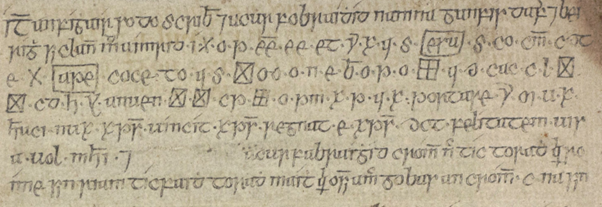Edinburgh, National Library of Scotland Adv. MS 72.1.2
Siobhán Barrett

Edinburgh, National Library of Scotland, Adv. MS 72.1.2, fol. 2v: A page from the illustrated zodiac. Image courtesy of Irish Script on Screen.
This sixteenth− and seventeenth-century manuscript of vellum and paper is composed of thirteen separate sections of varying dates, bound together. The catalogue suggests that it could be the work of 81 scribes. The manuscript belonged to a renowned family of Scottish medics, the Beatons from Mull; Fergus, Neil, James, Malcolm and John Beaton have all signed their names in various places (see also the March 2024 Manuscript of the Month entry below for another codex associated with this family). Other scribes named are Donnchadh Ó Conchubhair and Coinneach mac Eoin.
Since this is a composite codex consisting of disparate manuscripts, many of which are fragmentary, it contains a wide variety of subject matter. Some interesting inclusions are: astrological and astronomical texts, one of which is an illustrated zodiac; a portion of the wisdom-text Tecosca Cormaic, in which the legendary King Cormac gives advice to his son, Cairpre; a copy of the Irish translation of Bernard of Gordon’s teaching on lovesickness (see Deborah Hayden’s July 2024 LEIGHEAS project blog); a commentary on the Old Irish medico-legal text on sick-maintenance, Bretha Crólige (see also the January 2024 Manuscript of the Month entry below); advice on what days of the month are best for bloodletting; and a medical catechism (see Hayden 2016). There is a large number remedies for ailments of every sort, including some obstetrical cures that are specifically attributed to the women of Salerno. Among the many charms that are preserved in this manuscript is one for infertility in women and in trees, instructing the practitioner to write a series of letters and symbols on some kind of material which is then tied around the neck or the woman, or around the tree:

Edinburgh, National Library of Scotland, Adv. MS 72.1.2, fol. 33r1: A charm for infertililty in women and trees. Image courtesy of Irish Script on Screen.
Further reading:
- Anderson, O. O. (1909), ‘Ranna an Aeir’. Revue Celtique 30: 404–16
- Bannerman, John (2015), The Beatons: A Medical Kindred in the Classical Gaelic Tradition. 2nd ed. (Edinburgh: J. Donald)
- Hayden, Deborah (2016), ‘Observations on the “Doors of Death” in a Medieval Irish Medical Catechism’, in Rosa Anglica: Reasessements, ed. by Liam P. Ó Murchú, Irish Texts Society Subsidiary Series, 28 (London: Irish Texts Society), pp. 26–56
- Hayden, Deborah (2019), ‘The Lexicon of Pulmonary Ailment in Some Medieval Irish Medical Texts’, Zeitschrift für celtische Philologie 66: 105–29
- Meyer, Kuno, ed. (1909), The Instructions of King Cormac Mac Airt: Tecosca Cormaic. Todd Lecture Series 15 (Dublin: Hodges, Figgis & Co.)
- Rempt, Menna (2019), ‘“And Straightaway the Fountain of Her Blood Dried Up’ (Mark 5:29): Constructing a Template for Late Medieval Irish Obstetric Charms” (unpublished RMA thesis, Utrecht University)
- Thanisch, Eystein (forthcoming), ‘Knowing through Defining: Collections of Scientific Definitions in Gaelic Medical Manuscripts’, in Medicine in the Medieval North Atlantic World: Vernacular Texts and Traditions, ed. by Deborah Hayden and Sarah Baccianti (Turnhout: Brepols)